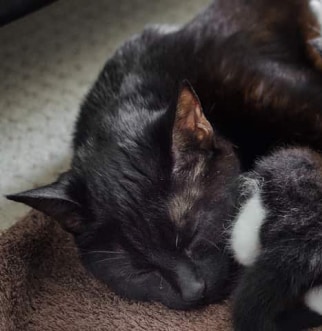

Seeing a cat having seizures is scary for any pet parent. Caused by abnormal electrical activity in the brain, seizures can cause concerning behaviors, including thrashing, drooling and teeth chomping. Cat seizures can take many forms but, thankfully, even though they look frightening, they're not always a medical emergency.
Read on to learn why cat seizures happen and what you should do if your cat ever has one.
Cat Seizure Causes
Cat seizures are grouped into two categories: intracranial seizures, which are caused by something that exists inside the skull, and extracranial seizures, which are caused by something outside the skull.
The causes of an intracranial seizure include:
- Brain tumors
- Brain infections
- Brain trauma and inflammation
- Brain parasites, such as toxoplasmosis
Extracranial seizures can be caused by:
- Liver or kidney disease
- Exposure to a flea or tick product that isn't meant for cats
- Ingestion of human medicine
- Heatstroke
- Infectious diseases
- High blood pressure
Your cat could also have a seizure as a result of epilepsy, which means that the seizure's cause is unknown.
Signs & Symptoms of a Cat Seizure
Cat seizures can take many forms. Generalized or grand mal seizures can include convulsions, limb rigidity or paddling, loss of consciousness, abnormal vocalization and loss of urinary or bowel control. Grand mal seizures can occur alone or in clusters and typically last a minute or two. If a seizure lasts longer than five to 10 minutes then it's called "status epilepticus," and is a medical emergency; you should take your cat for emergency veterinary care immediately. However, you should take your cat to see your veterinarian following any seizure just to get a full checkup and diagnosis.
Other types of seizures, such as absence seizures or partial seizures, during which a cat may exhibit tail chasing, aggression, shadow chasing or biting, are very rare.
Since seizures tend to be very brief, you may not notice your cat having one. Alternatively, you may notice abnormal behavior after a seizure, during what's known as the postictal phase. Your cat may exhibit excessive tiredness or excitement, binge eating and drinking, or abnormal pacing. If you notice any of these signs, contact your veterinarian.
What to Do If Your Cat Has a Seizure
Unless a cat is in status epilepticus, cat seizures are rarely a medical emergency, meaning that you do not have to go to the emergency center immediately. If you notice your cat having a seizure but it stops after one to two minutes, then you should call your veterinarian and make an appointment to have your cat seen as soon as possible. If they are short but back-to-back, or they have more than one, you should take your cat to the veterinarian immediately.
While your cat is having a seizure (and even after), don't touch them unless they're at risk of hurting themselves — if they're about to fall down the stairs or into deep water, for example. If you touch your cat while they're seizing, you risk the chance of getting a serious bite or scratch.
If the seizure isn't stopping, you should take your cat for emergency care. Use a thick towel to pick up and wrap your cat for safe transportation. At the veterinarian's office, be prepared to answer questions about your cat's health history, including questions about:
- The number, frequency and length of their seizures
- Their vaccination history
- Whether they're an indoor or outdoor cat
- Nutrition and feeding
- Whether they've been vomiting or having diarrhea
- Recent weight changes
Your answers to these questions will help your veterinarian recommend the appropriate testing and treatment. Testing can include blood and urine tests, fecal tests and/or imaging studies, such as X-rays, ultrasounds and MRIs.
Treatment for a Cat Having Seizures
If your cat is in status epilepticus, then the veterinary team will provide emergency care; this can include placement of an intravenous catheter, administration of anticonvulsant medicine (a medication that is used to help prevent or stop seizures, sometimes referred to as "anti-seizure") and collection of blood and urine samples for analysis.
If their seizures are rare, your cat may not require medicine, but if seizures are happening more often than every six to eight weeks, then treatment may be necessary to prevent further brain damage.
If a cat is stable and not currently seizing, then treatment may consist of oral anticonvulsant medicine and treatment of any underlying causes. If your veterinarian prescribes your cat medicine, it's important to follow the dosing instructions. Changing the dose or suddenly stopping the medicine could cause seizures to resume or worsen.
The Connection Between Cat Seizures and Nutrition
If your cat is having issues with seizures, a veterinarian should evaluate their nutrition. If your cat is suffering from a disease elsewhere in the body that can cause seizures, such as liver disease or kidney disease, proper nutrition can help reduce the effects these diseases have on the brain.
Any cat, including one that is experiencing seizures or neurological signs, can benefit from eating a complete and balanced food that's high in antioxidants and omega-3 fatty acids, unless otherwise directed by your veterinarian.
Cat seizures are always scary to witness, but luckily, very rare for cats. Proper veterinary care can often resolve whatever is causing the condition and get your kitty back to feeling like themselves.







